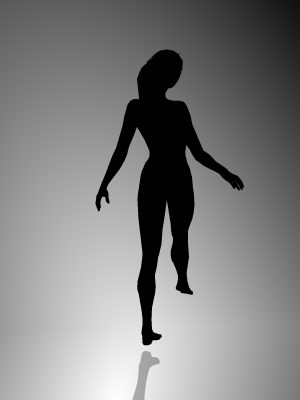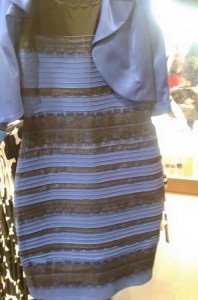Dec
27
2010
 Three years ago I wrote a post about a popular illusion – the spinning girl or silhouette illusion. This is a popular online illusion, and also remains my most popular post. (Original illusion by Nobuyuki Kayahara here.) The popularity of this illusion seems to be tied to the fact that it is used in many online quizzes, with the claim that the direction in which you see the girl spin will tell you which side of your brain is dominant. In my prior post I primarily addressed that claim – explaining that the “left brain – right brain” thing is all nonsense, and which way the girl appears to spin tells you nothing about your personality or talents. (Briefly – while many neurological functions are lateralized to one side of the brain or the other, both hemispheres are massively connected and work together to form your abilities and personality.)
Three years ago I wrote a post about a popular illusion – the spinning girl or silhouette illusion. This is a popular online illusion, and also remains my most popular post. (Original illusion by Nobuyuki Kayahara here.) The popularity of this illusion seems to be tied to the fact that it is used in many online quizzes, with the claim that the direction in which you see the girl spin will tell you which side of your brain is dominant. In my prior post I primarily addressed that claim – explaining that the “left brain – right brain” thing is all nonsense, and which way the girl appears to spin tells you nothing about your personality or talents. (Briefly – while many neurological functions are lateralized to one side of the brain or the other, both hemispheres are massively connected and work together to form your abilities and personality.)
The real question prompted by this illusion is why do we perceive it as rotating one way or the other, and is there a preference. It turns out, most people will see the girl spinning clockwise. You can get her to switch and spin the opposite way to your original perception – but when first looking at the illusion most people will see her spinning clockwise.
Continue Reading »
Oct
11
2007
Take a look at the spinning girl below. Do you see it spinning clockwise or counter-clockwise? I see it spinning counter-clockwise, and I had a hard time getting it to switch direction. Give it a try. 
These kinds of optical illusions are always fun. What they reveal is how our brain processes visual information in order to create a visual model of the world. The visual system evolved to make certain assumptions that are almost always right (like, if something is smaller is it likely farther away). But these assumptions can be exploited to created a false visual construction, or an optical illusion.
The spinning girl is a form of the more general spinning silhouette illusion. The image is not objectively “spinning” in one direction or the other. It is a two-dimensional image that is simply shifting back and forth. But our brains did not evolve to interpret two-dimensional representations of the world but the actual three-dimensional world. So our visual processing assumes we are looking at a 3-D image and is uses clues to interpret it as such. Or, without adequate clues it may just arbitrarily decide a best fit – spinning clockwise or counterclockwise. And once this fit is chosen, the illusion is complete – we see a 3-D spinning image.
Continue Reading »
Sep
30
2013
This is not a reference to the spinning dancer optical illusion, but rather to real dancers. Why don’t ballet dancers get dizzy when they spin around? Partly this is due to technique – a technique called spotting, in which dancer keep their head in one position for as long as possible then rotate it around quickly back to their fixed position. You have likely noticed this while watching ballet dancers.
But spotting does not entirely explain the ability of experienced dancers to tolerate spinning without becoming vertiginous. A new study finds that brain plasticity is also playing a role – the brains of experienced dancers adapt by reducing the signals that would cause dizziness.
To clarify, the term “dizzy” is a bit non-specific. People use it to mean vertigo (the sense of spinning or movement), but also light-headedness (feeling as if you might pass out), just being off balance, or even for any vague sensation in the head. What is being addressed in this study is vertigo, the feeling you get if you spin around.
Continue Reading »
Feb
27
2015
 This is pretty amazing – almost as much for how quickly this has gone viral as for the effect itself. There is now an intense debate going on in the intertubes over whether this dress is black and blue or white and gold. Take a look and decide for yourself. Buzzfeed has a poll which currently puts it at 72% white and gold, and 28% black and blue. Right now there are about 2 million votes, so that is probably statistically significant.
This is pretty amazing – almost as much for how quickly this has gone viral as for the effect itself. There is now an intense debate going on in the intertubes over whether this dress is black and blue or white and gold. Take a look and decide for yourself. Buzzfeed has a poll which currently puts it at 72% white and gold, and 28% black and blue. Right now there are about 2 million votes, so that is probably statistically significant.
I see black and blue, no matter what screen or version of that picture I look at. It does not seem to be an issue with the monitor or viewing conditions.
The reason, in my opinion, this has gone so viral so quickly is that people are legitimately freaked out by the realization that how they see the world is ultimately a subjective construction of our brains. Taylor Swift tweeted about the debate:
“I don’t understand this odd dress debate and feel like it’s a trick somehow. I’m confused and scared. PS It’s OBVIOUSLY BLUE AND BLACK.”
That about sums it up. She thinks it must be a trick (it is – a trick of the brain), and is scared and confused. At the same time she is caps-lock-certain that her perception of the dress’s color is the objective truth.
Continue Reading »
Aug
07
2009
New research builds upon the growing body of research into how our brains give us a sense that we are inside our bodies. That is one of the brain’s functions that we take for granted – and do not even realize that it is a function of the brain or that it is necessary – until it is not functioning. When that happens we have an out-of-body experience (OBE).
Prior to modern neuroscience, OBEs were interpreted as mystical or spiritual experiences. In many cultures they were provoked by drugs during spiritual rituals. They have also been reported during certain dream states and in near-death experiences.
Unless one is a neuroscientist or has a keen interest in how the brain works, we tend to think of our mental selves as an integrated whole and not as a collection of independent functions – the latter is more close to the truth. Our brains are more like committees with many different parts carrying out specific functions – some conscious, some unconscious. But since we are our brains we are only aware of the net effect of that part of our brain function that produces our conscious awareness and attention. We are not aware of the bickering committee operating behind the scenes, and therefore we are not aware of all the subconscious tasks being carried out by individual components of our brains.
Continue Reading »
Feb
15
2018
 A couple months ago I received my first virtual reality (VR) headset, and have been experimenting with various games and apps since. (Here is my initial review.) As a neuroscientist, it is a fascinating demonstration of how our brains construct our experience of reality.
A couple months ago I received my first virtual reality (VR) headset, and have been experimenting with various games and apps since. (Here is my initial review.) As a neuroscientist, it is a fascinating demonstration of how our brains construct our experience of reality.
What I and everyone who has used my gear has experienced is surprise at how visceral VR can be. It’s just a big video, right, so why do our lizard brains react so strongly? The most dramatic example is an app called “The Plank Experience”. In it you take an elevator up to a high floor in a skyscraper. The door opens to reveal a plank going out over the street far below. Everyone so far is frozen at the moment the doors open and they see the chasm below them. Some can walk out onto the virtual plank, but most people hesitate and at least one person bailed and would not do it.
What is interesting is that when I stepped out onto the plank, I completely 100% knew that I was standing on the carpet in my office, totally safe and at no peril at all. However, the part of my brain that knew I was safe was in conflict with a deeper and more primitive part of my brain that was screaming, “Danger, danger.” It took an effort of will to overcome the fear, but I could not make the fear go away.
Let me describe one other part of the VR experience and then I’ll discuss what is going on neurologically. Motion sickness has been a major challenge for VR. All of the games and apps I have used so far have an option (usually the default) where if you have to move your character in the VR world you do it by teleporting. You use the control to place an X on the floor where you want to go, and then you are instantly in that location. This type of movement does not produce any motion sickness.
Continue Reading »
May
17
2010
I was recently asked about the legitimacy of sperm sorting as a way to choose the gender of your child. This is a topic I had been researching for another project anyway, so I thought I would report my findings. This is a good topic for skeptics because it may seem dubious at first glance, but in fact there is serious science behind sperm sorting. But there is also some pseudoscience mixed in.
Genetic gender is entirely determined by the sperm from the male. Women have two X chromosomes and so can only contribute an X. Men have one X and one Y, and so can contribute one or the other, which determines the sex chromosomes of the child. (I wrote “genetic gender” because there are non-genetic hormonal factors in the womb and hormonal abnormalities that can influence sexual development.) Therefore roughly half of the sperm rushing to be the victor in the conception race carry one X chromosome and will result in a girl, while the other half carry one Y chromosome and will result in a boy.
If we could separate out the Ys from the Xs, then we could control the resulting gender of the child. The X chromosome is larger than the Y. Since each sperm is essentially just a tight packet of genetic material connected to a tail, the weight of each sperm is largely determined by the weight of each chromosome.
Continue Reading »
 Three years ago I wrote a post about a popular illusion – the spinning girl or silhouette illusion. This is a popular online illusion, and also remains my most popular post. (Original illusion by Nobuyuki Kayahara here.) The popularity of this illusion seems to be tied to the fact that it is used in many online quizzes, with the claim that the direction in which you see the girl spin will tell you which side of your brain is dominant. In my prior post I primarily addressed that claim – explaining that the “left brain – right brain” thing is all nonsense, and which way the girl appears to spin tells you nothing about your personality or talents. (Briefly – while many neurological functions are lateralized to one side of the brain or the other, both hemispheres are massively connected and work together to form your abilities and personality.)
Three years ago I wrote a post about a popular illusion – the spinning girl or silhouette illusion. This is a popular online illusion, and also remains my most popular post. (Original illusion by Nobuyuki Kayahara here.) The popularity of this illusion seems to be tied to the fact that it is used in many online quizzes, with the claim that the direction in which you see the girl spin will tell you which side of your brain is dominant. In my prior post I primarily addressed that claim – explaining that the “left brain – right brain” thing is all nonsense, and which way the girl appears to spin tells you nothing about your personality or talents. (Briefly – while many neurological functions are lateralized to one side of the brain or the other, both hemispheres are massively connected and work together to form your abilities and personality.)

 A couple months ago I received my first virtual reality (VR) headset, and have been experimenting with various games and apps since. (
A couple months ago I received my first virtual reality (VR) headset, and have been experimenting with various games and apps since. (




